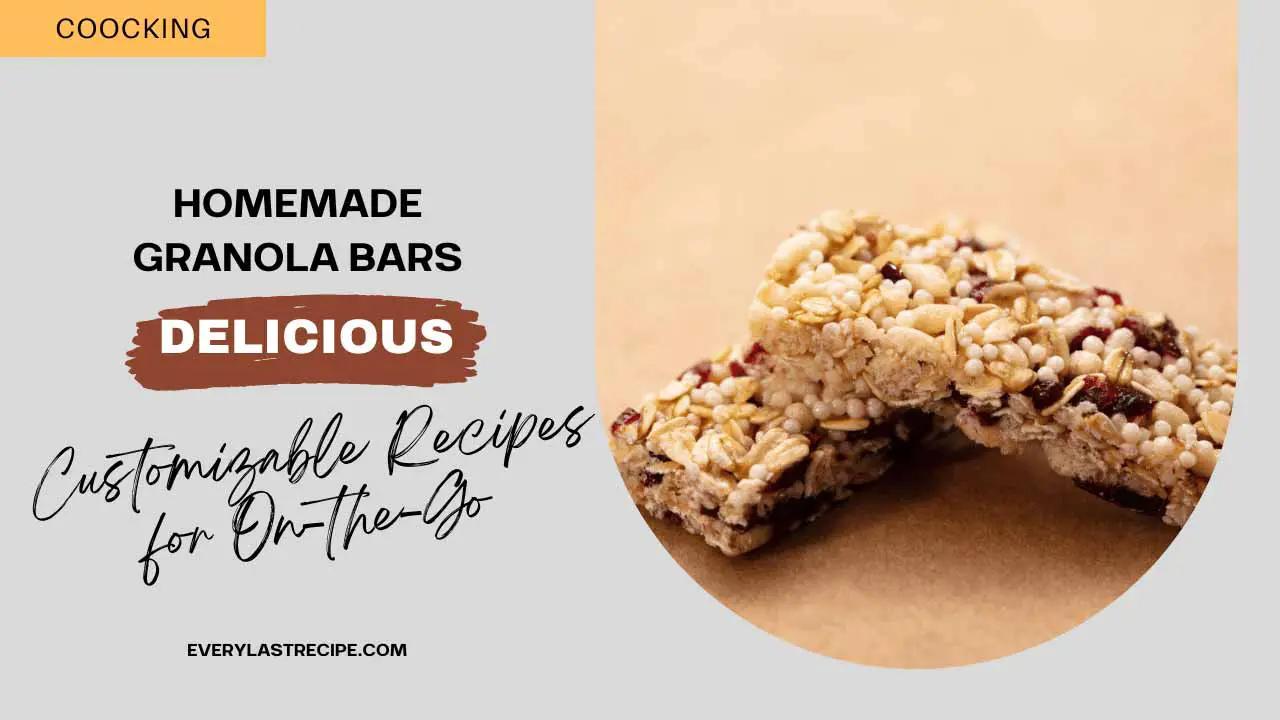Granola bars have become a staple in our fast-paced lives, offering a convenient and satisfying snack option for those moments when hunger strikes on the go. These bars typically contain oats, nuts, seeds, dried fruits, and honey.
While they can undoubtedly be a nutritious choice, it’s essential to note that not all store-bought options are created equal – many can harbor hidden sugars and excessive calories. The solution?
Taking matters into your own hands and crafting homemade granola bars. Not only does this grant you control over the ingredients, but it also allows you to cater these bars to your exact preferences.
Contents
The Benefits of Making Your Own Granola Bars:
Crafting your granola bars at home offers a plethora of advantages that go beyond mere taste. Here are a few of the key benefits:
1. Ingredient Control:
Choosing your ingredients thoughtfully is one of the most significant advantages of making granola bars at home. Opt for wholesome options like whole grains, nuts, and seeds while removing added sugars and artificial flavor enhancers.
2. Customizable Flavors:
Homemade granola bars are a blank canvas waiting for your creative touch. Mix and match different nuts, seeds, dried fruits, and spices to create a unique flavor profile that appeals to your taste buds. You can even experiment with delightful additions like chocolate chips and peanut butter.
3. Cost-Effective:
Pre-packaged granola bars can be pricey. Preparing your bars allows you to save money by utilizing ingredients you already have on hand. It’s a budget-friendly way to indulge in a nutritious snack.
4. Freshness:
Unlike their store-bought counterparts, homemade granola bars retain an unbeatable sense of freshness. Shielded from excessive air and light exposure, these bars maintain their optimal taste and texture.
5. Satisfying Nutrition:
Thanks to the inclusion of whole grains, nuts, and other nutritious components, homemade granola bars tend to offer more satiety compared to commercially available options. You’ll find that they can keep hunger pangs at bay more effectively.
Also read: Smoothie Bowl Combinations Recipe
How to Make Homemade Granola Bars:
Creating your granola bars is a straightforward process that yields delicious results. Here’s a rundown of the basic steps:
- Preheat your oven to 350 degrees Fahrenheit.
- Line a baking sheet with parchment paper to prevent sticking.
- Combine your choice of oats, nuts, seeds, and dried fruit in a sizable bowl.
- Whisk together honey, oil, and a touch of vanilla extract in a separate bowl.
- Pour the wet mixture into the dry ingredients and stir until a cohesive blend forms.
- Firmly press the amalgam onto the prepared baking sheet.
- Bake for 15-20 minutes or until the bars display a golden-brown hue.
- Allow the bars to cool entirely before gently cutting them into your desired size.
Tips for Making Homemade Granola Bars:
To elevate your granola bar crafting skills, consider these useful tips:
- 1. Diverse Ingredients: Integrate an array of ingredients to construct both flavorful and nutritionally well-rounded bars.
- 2. Fearless Experimentation: Don’t be afraid to think outside the box. Play around with unique flavor combinations that cater to your personal preferences.
- 3. Sticky Sweeteners: Use sticky natural sweeteners such as honey or maple syrup to bind the ingredients seamlessly.
- 4. Proper Pressing: Press the mixture onto the baking sheet with ample pressure. This helps ensure the bars hold their shape after baking.
- 5. Cooling is Crucial: Patience is key. Allow the bars to cool fully before cutting them. This helps maintain their structural integrity.
- 6. Smart Storage: After the creative process, store your homemade granola bars in an airtight container at room temperature for up to a week.
Recipes for Customizable Granola Bars:
Here are a few enticing recipes to spark your granola bar journey:
- 1. Basic Granola Bars: A fantastic starting point, these simple bars serve as a foundation for creative experimentation.
- 2. Fruity Granola Bars: Elevate the basic recipe with dried fruits and an assortment of nuts for an extra layer of flavor.
- 3. Chocolate Chip Granola Bars: A universally beloved favorite, these bars combine the wholesome goodness of oats and nuts with the indulgence of chocolate chips.
- 4. Peanut Butter Granola Bars: Packed with protein and fiber, this variation incorporates the creamy richness of peanut butter.
- 5. Chewy Granola Bars: This recipe uses eggs as a binding agent, resulting in chewy, delectable bars.
Conclusion:
Homemade granola bars offer a delightful way to snack healthily and tastefully. Crafted carefully, these bars supply the body with essential nutrients from whole grains, nuts, seeds, and more.
The cost-effectiveness and creative potential of making your bars make this DIY endeavor satisfying and rewarding.
So, why not unleash your inner culinary artist and concoct your batch of delicious granola bars? Your taste buds and your well-being will surely thank you.
FAQs
1. Are homemade granola bars healthier than store-bought options?
Yes, homemade granola bars can be healthier than many store-bought options. When you make your granola bars, you have control over the ingredients you use. You can choose whole grains, nuts, seeds, and natural sweeteners, avoiding added sugars and artificial additives. This allows you to create a nutritious snack that aligns with your dietary preferences and health goals.
2. Can I make granola bars if I have dietary restrictions?
Absolutely! Homemade granola bars are incredibly versatile and can be tailored to accommodate various dietary restrictions. If you’re gluten-sensitive, you can use gluten-free oats. For nut allergies, opt for seeds and dried fruits as alternatives. Choose plant-based sweeteners and binders like maple syrup and nut butter if you’re vegan.
3. How do I ensure my granola bars hold together well?
The right texture and cohesion in granola bars involves choosing the right binding ingredients. Sticky sweeteners like honey, maple syrup, or agave nectar help hold the ingredients together. Additionally, pressing the mixture firmly into the baking sheet before baking ensures that the bars maintain their shape once cooled. Including ingredients like nut butter or egg whites can also enhance binding.
4. Can I use fresh fruits instead of dried fruits?
While dried fruits are commonly used in granola bars due to their longer shelf life and concentrated sweetness, you can experiment using fresh fruits in your recipes. Remember that fresh fruits contain more moisture, which can affect the texture and shelf life of the bars. To use fresh fruits, consider reducing the moisture content by baking or dehydrating them slightly before incorporating them into the mixture.
5. How should I store homemade granola bars?
To keep your homemade granola bars fresh and delicious, store them in an airtight container at room temperature. If the bars are exposed to moisture or air, they might lose their crispness and become chewy. Proper storage can help maintain their texture and flavor for up to a week. To extend their shelf life, refrigerate or freeze the bars and thaw them as needed.









